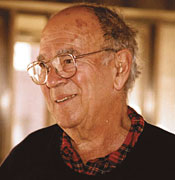David Lazarus
DOI: 10.1063/PT.3.1484
David Lazarus passed away on his 90th birthday, 8 September 2011. A professor of physics emeritus at the University of Illinois at Urbana-Champaign (UIUC), Lazarus was a distinguished condensed-matter physicist, a highly regarded teacher at all levels, and a staunch advocate for basic scientific research and its impact on society. As editor-in-chief of the American Physical Society (APS) from 1980 to 1991, he was in charge of all the society’s research journals.
Born in Buffalo, New York, in 1921, Lazarus began his career in physics during World War II, years before he obtained his PhD. At the height of the war, he took a job as a researcher at the Harvard Radio Research Laboratory, established to develop wartime countermeasures to radar. He was instrumental in the development and deployment of airborne radar-jamming devices, an important factor in preventing the German defenses from detecting Allied airborne attacks.
After the war, Lazarus returned to the University of Chicago, where he had received his BS in physics in 1942, and joined the newly established Institute for the Study of Metals (now the James Franck Institute). As a graduate student, he was so adept at constructing and using instrumentation that he was in great demand by research groups. With Andrew Lawson as adviser, he produced the first PhD thesis completed at the institute; he used the pulsed-ultrasound techniques he had learned during the war to study the elastic constants of alkali halides and metals at high pressure.
In 1948, F. Wheeler Loomis, head of UIUC’s physics department, asked Frederick Seitz to recruit a handful of able, young scientists to build a new center for solid-state physics; Lazarus joined the group the next year. Loomis’s vision resulted in a leading center of condensed-matter physics research and teaching that endures today at UIUC.
At the time Lazarus came to UIUC, it had become clear that crystal lattice defects would be critical to the understanding of the properties of solids. He chose to study point defects (primarily vacancies) by measuring diffusion in solids. Radioactive isotopes had become commercially available, so he launched a systematic study of tracer diffusion in metal single crystals. Even though he was not an expert in the field, his experimentalist’s instinct and skill in mechanical design enabled him to obtain fundamental, accurate, reproducible data.
Lazarus’s group included Lawrence Slifkin as his first postdoc and one of us (Tomizuka) as his first graduate student. The group made self-diffusion measurements in single crystals of silver that became a standard of reproducibility and reliability and formed a basis of future work in the field. One of Lazarus’s early results was the discovery of a systematic dependence of activation energies on the ionic charges of host and diffusant. His grasp of theoretical physics enabled him to provide a durable model, the Thomas–Fermi screening model, for the diffusion of impurities in metals.
Lazarus’s group was a driving force in the exploration of fundamental aspects of the lattice vacancy, its generation, and its migration. His group clarified diffusion-associated issues such as the correlation effect, an experimentally elusive aspect of vacancy motion. He and graduate student Alan Schoen were the first to recognize that the isotope effect was the most effective tool for investigating such questions. That insight provided the major thrust for the diffusion group at Argonne National Laboratory, with which Lazarus worked closely. Beginning in the early 1960s, he exploited high pressure as an effective experimental parameter and created an elegant hydrostatic cell to measure optical properties of ionic crystals at high pressure.
Lazarus was highly regarded as one of UIUC’s best professors. He thought both scientists and nonscientists should appreciate physics and its effects on all aspects of people’s lives. To that end he taught two courses for nonscientists: Physics for Poets, and Practical Physics—How Things Work. The World of Physics, a high school textbook he wrote with colleague Robert Hulsizer, was published in 1972.
After his retirement from UIUC in 1987, Lazarus continued as editor-in-chief of APS. Lazarus approached the editorial job as an author of scores of research papers. He defended authors’ rights and editorial fairness, helped stabilize APS’s financial status by instituting better-calibrated subscription practices, enhanced the status of Physical Review Letters, and recruited senior physicists to serve as editors and associate editors while they continued working at their home institutions. Lazarus and Harry Lustig, then APS treasurer, successfully defended APS against lawsuits and protected the confidentiality of its refereeing process.
David Lazarus will be remembered by his colleagues and students, including the 44 PhD candidates he supervised, as a wise, cheerful guide to appreciating and contributing to the beauty of physics. He also was an exemplar of how to live a full life and take joy in family, the arts, and other pursuits outside of science. Condensed-matter physics and APS benefited greatly from his long career, but we who were privileged to know him gained the most.

David Lazarus

More about the Authors
Benjamin Bederson. New York University, New York City.
Carl Tomizuka. University of Arizona, Tucson.
Laurie McNeil. University of North Carolina, Chapel Hill .




